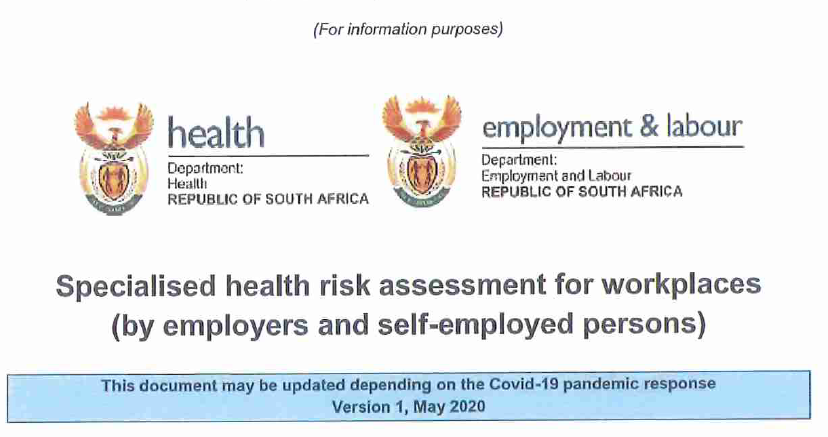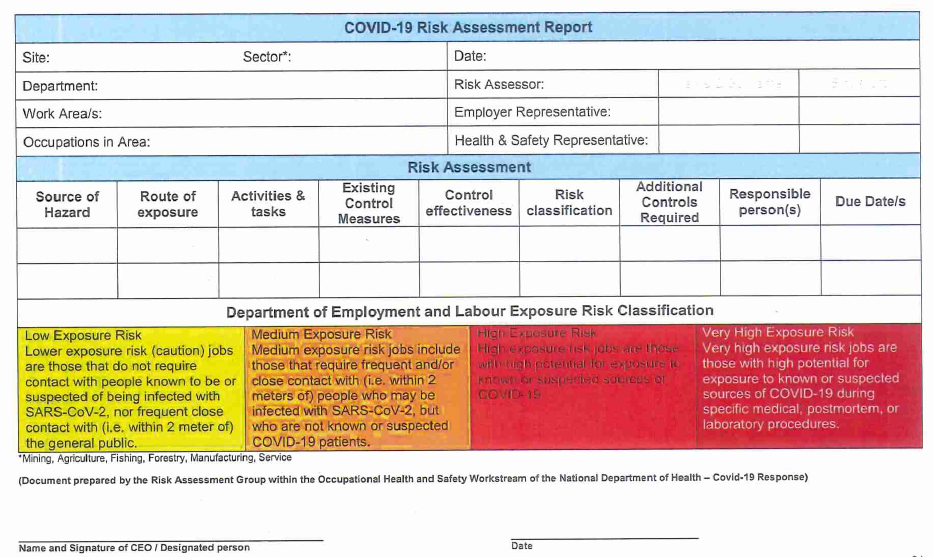


Mine Health and Safety Act, 1996 (Act No. 29 of 1996)NoticesGuideline for the Compilation of a Mandatory Code of Practice for the Prevention, Mitigation and Management of COVID-19 outbreakAnnexuresAnnexure 2: Specialised health risk assessment for workplaces (by employers and self-employed persons) |
ANNEXURE 2

Purpose
This guide is to be used by employers or self-employed persons to assess the potential risk of exposure to SARS-CoV-2 virus and control measures at all workplaces. (SARS-CoV-2 virus is the causative virus of Covid-19).
Objectives
| (i) | To identify and assess the potential risk of exposure to SARS-CoV-2 virus at workplaces |
| (ii) | To identify control measures (or the absence of control measures) and assess their effectiveness to reduce the risk of transmission of SARS-CoV-2 virus from recognised and unrecognised sources of infection in a workplace |
| (iii) | To inform the employer of the risk of potential exposure to SARS-CoV-2 virus and additional controls that might be required. |
Requirements for the protection of employees against hazardous biological agents (HBA) such as SARS-CoV-2 virus are covered in the South African Occupational Health and Safety Act, 1993, Regulations for Hazardous Biological Agents ,2001.
This guide serves as a departure point for employers, self-employed persons and appropriately qualified persons to guide their COVID-19 Risk Assessments. This content must not be regarded as the absolute content of a Risk Assessment, rather it is the minimum requirements. Page 2 of 5
| 1. | Risk assessment by the employer or self-employed person |
| 1.1. | Regulation 6(1) of the Regulations for Hazardous Biological Agents (2001) requires an employer or self-employed person to determine if any person might have been exposed to a HBA. |
| 1.2. | The relevant health and safety representative or relevant health and safety committee must first be consulted before proceeding with the risk assessment. |
| 1.3. | The employer must inform the relevant health and safety representative or relevant health and safety committee in writing of the arrangements made for the risk assessment, give them reasonable time to comment thereon and ensure the outcomes and findings of the risk assessments are made available to the relevant health and safety representative or relevant health and safety committee, which may comment thereon. |
| 1.4. | The employer or self-employed person must keep a record of the risk assessment and take into account matters such as: |
| (i) | the nature and dose of the SARS-CoV-2 virus to which an employee may be exposed and the suspected route of exposure and exposure scenarios; |
| (ii) | where SARS-CoV-2 virus might be present and in what physical form it is likely to be; |
| (iii) | the nature of the work, process and any reasonable deterioration, or failure of, any control measure; |
| (iv) | what possible effects the SARS-CoV-2 virus can have on an employee; and |
| (v) | the period of exposure |
| 1.5. | An employer or a self-employed person must cause the risk assessment to be conducted by persons competent In their respective areas based on all available information as far as is reasonably practicable, including: |
| (i) | classification of SARS-CoV-2 virus into the relevant risk group, according to its level of risk of infection; |
| (ii) | recommendations from Organisations such as the World Health Organization (WHO) or a competent person regarding the control measures necessary in order to protect the health of employees against SARS-CoV-2 virus as a result of their work; and |
| (iii) | knowledge of diseases from which employees might be suffering and which may be aggravated by conditions at the workplace. |
| 1.6. | An employer must review the risk assessment if there— |
| (i) | Is a reason to suspect that the previous assessment is no longer valid; or |
| (ii) | Has been a change in a process involving SARS-CoV-2 virus or in the methods, equipment or procedures in the handling, controlor processing of COVID-19 samples or patients. |
| (iii) | Has been a change in a processes as a result of SARS-CoV-2 virus or in the methods, equipment or procedures in the handling, controlor processing at the workplace. |
| (iv) | Following a suspected or confirmed COVID-19 case at the workplace. |
| 1.7. | The outcomes and findings of the risk assessments must inform the programme to monitor the exposure of employees to COVID-19 as well as the programme of medical surveillance. |
| 2. | Risk management and control measures |
| 2.1. | Annexure 2 of the Regulations for Hazardous Biological Agents (2001) sets out a hierarchy of control measures using standard and transmission-based precautions. |
| 2.2. | Personal protective equipment should be appropriate to the route of transmission e.g. respirators, impermeable gloves, supply, selection, training, separate storage, decontamination or sterilisation. |
| 2.3. | Testing of engineering control measures should be conducted every 24 months by an approved HBA inspection authority (retaining records for at least 3 years). |
| 2.4. | Annexure D of the Regulations for Hazardous Biological Agents (2001) sets out requirements for the labelling, packaging, transporting and storage in special containers marked with the biohazard sign in medical settings. In non-medical settings which includes low and medium risk, disposal of "non contaminated PPE" can take place through normal disposal means. |
| 2.5. | The employer must have written procedures for disposal of HBA to a designated site in terms of the Environmental Conservation Act and decontamination or disinfection of all containers in the medical environment. |
| 2.6. | The normal mode of disposing of items of PPE can take place through the normal means of disposing of non-contaminated trash. |
| 3. | Competencies |
| 3.1. | The Regulations for Hazardous Biological Agents (2001) do not define any competency requirements for conducting HBA risk assessments (or for the monitoring of exposure at the workplace).Employers and self-employed persons are advised to ensure anyone engaged to undertake an HBA risk assessment is competent in risk assessment processes and is familiar with the Regulations for Hazardous Biological Agents (2001). Knowledge of the HBA of concern (in this case SARS-CoV-2 virus) and HBA in general is advisable. It is recommended that the services of a registered Occupational Hygienist or certified Safety Professional is obtained to undertake the COVID-19 risk assessments. |
| 3.2. | Regulation 12(b) of the Regulations for Hazardous Biological Agents (2001) requires that examinations and tests of engineering control measures be carried out at intervals not exceeding 24 months by an approved HBA inspection authority or by a person whose ability to do the measurements, analysis and tests is verified by such an approved HBA inspection authority. |
| 4. | Guidance notes |
| 4.1. | Anticipated high exposure areas that will need immediate assessment. then others that will require assessment, less urgently include the following areas: |
| • | Entry points to the workplace Change house facilities |
| • | On-site canteen and similar dining areas Waiting areas |
| • | Waiting areas |
| • | Gathering places |
| • | Etc. |
| 4.2. | Persons Under Investigation (PUI) |
The risk assessment must include screening of employees entering the workplace, and the immediate provision of surgical masks at the gate to those screening positive will be a major hazard control. The risk assessment should also include chaperoning of PUI to the next point at the workplace (PUl should not be left wandering around, getting lost, removing mask etc.). Preferably, a cordoned-off walkway (or at least marked walkway) should be present directing the PUI to the next point at the workplace - ideally to an isolation zone. The risk assessment must also include assessments of the controls within this isolation zone - 1.5m spacing, presence of barriers etc.
